Translate this page into:
Integrated network pharmacology and comprehensive bioinformatics identifying the mechanisms and molecular targets of Jieyu Anshen Granules for treating comorbidity with Alzheimer's disease and depression
⁎Corresponding author at: Department of Neurology, The Second Hospital of Hebei Medical University, Shijiazhuang, Hebei 050000, China. wangshan412@163.com (Shan Wang)
-
Received: ,
Accepted: ,
This article was originally published by Elsevier and was migrated to Scientific Scholar after the change of Publisher.
Abstract
Jieyu Anshen Granules (JY) is a traditional Chinese medicine formula commonly used as an adjuvant treatment for Alzheimer's disease (AD) complicated with depression. However, the specific underlying mechanisms and therapeutic targets of JY remain unclear. We used the TCMSP, TCMID, BATMAN-TCM, and other databases to screen the components and assumed targets of JY. Next, the GEO and DisGeNET databases were used to identify the related targets of both AD and Major Depressive Disorder (MDD). Enrichment analyses of core targets were performed, and the main components and core targets of JY for the comorbidity of AD and MDD were identified via protein–protein interaction (PPI) network construction and machine learning algorithms. Lastly, we verified binding affinity using the AutoDock software and molecular docking was performed. A total of 171 components were identified from JY, and 979 targets were obtained from the screening process. Bioinformatics analysis displayed 397 differentially expressed genes (DEGs) were shared by AD and MDD. Gene Ontology (GO) and Kyoto Encyclopedia of Genes and Genomes (KEGG) functional enrichment analysis revealed significant enrichment of genes associated with neurotransmitter receptor activity, G protein-coupled amine receptor activity, as well as signaling pathways such as the cAMP signaling pathway, PI3K-Akt signaling pathway, and cholinergic synapses. Through the PPI network and machine learning, we identified three hub genes (Ataxia telangiectasia-mutated gene [ATM], Colony stimulating factor 1 receptor [CSF1R], EPH receptor B2 [EPHB2]) as potential therapeutic targets. Molecular docking confirmed that the components of JY (Mairin, Hederagenin, 3-Epioleanolic Acid) could effectively bind to multiple key targets. This study revealed the effective components and potential mechanisms associated with JY treatment regarding AD and MDD comorbidities, offering valuable insights into promising therapeutic targets for subsequent studies.
Keywords
Jieyu Anshen Granules
Alzheimer's disease
Major depressive disorder
Network pharmacology
Machine learning
Molecular docking
Abbreviations
- JY
-
Jieyu Anshen Granules
- MDD
-
Major Depressive Disorder
- DEGs
-
Differentially expressed genes
- CSF1R
-
Colony stimulating factor 1 receptor
- TCM
-
Traditional Chinese medicine
- DC
-
Degree centrality
- CC
-
Closeness centrality
- MF
-
Molecular function
- SSRIs
-
Selective serotonin reuptake inhibitors
- AMPAR
-
AMPA-type-glutamate-receptor
- GLP-1
-
Glucagon-like peptide-1
- SSB2
-
Saikosaponins B2
- OB
-
Oral Bioavailability
- AUC
-
Area under the ROC curve
- KEGG
-
Kyoto Encyclopedia of Genes and Genomes
- AD
-
Alzheimer's disease
- PPI
-
Protein-protein interaction
- ATM
-
Ataxia telangiectasia-mutated gene
- EPHB2
-
EPH receptor B2
- 5-HT
-
5-hydroxytryptamine
- BC
-
Betweenness centrality
- BP
-
Biological process
- GSEA
-
Gene Set Enrichment Analysis
- NMDAR
-
N-methyl-D-aspartate-receptor
- CNS
-
Central nervous system
- ROS
-
Reactive oxygen species
- CUMS
-
chronic unpredictable mild stress
- DL
-
Drug Trad
- GO
-
Gene Ontology
1 Introduction
Alzheimer's disease (AD), an insidious, progressive and fatal neurodegenerative disease, is the most common form of dementia and accounts for 60–80 % of all types of dementia (Scheltens et al., 2021). Since its pathogenesis remains unclear, there is presently no cure other than medication for temporary symptomatic relief (Conte and Paci, 2022, Varesi et al., 2022). Depression and depressive symptoms in AD contribute to an increased risk of behavioral disorders, accelerated cognitive decline, reduced quality of life, and higher mortality rates (Hammar et al., 2022). Major depressive disorder (MDD) is a common mental illness characterized by a lack of interest in daily life, insomnia, cognitive impairment, feelings of worthlessness, and even suicidal thoughts (Pu et al., 2021). Older individuals with MDD often experience cognitive deficits, and recent studies have demonstrated a neurobiological and clinical correlation between depression and AD (Pu et al., 2021, Botto et al., 2022). Depression is a risk factor for the development of AD, and the presence of depressive symptoms significantly increases the transition from mild cognitive impairment (MCI) to AD (Caraci et al., 2018). Common pathophysiological events, including hippocampal atrophy and molecular pathways associated with oxidative stress and neuroinflammation, have been reported in both AD and MDD, involving signaling molecules such as Aβ, BDNF, GSK-3β, TNF-α, and TGF-β1 (Juszczyk et al., 2021, Dolotov et al., 2022). However, the specific pathophysiological mechanisms underlying the association between depression and AD remain unclear. Exploring the pathogenesis of AD complicated by depression and developing new treatments is essential for improving the quality of life of affected patients. Currently, antidepressants are the primary treatment for individuals with AD and depression (Juszczyk et al., 2021, Wang et al., 2022). However, individuals with AD and MDD comorbidities are particularly vulnerable to the limitations of conventional antidepressant treatment, including side effects (such as anxiety, loss of appetite, and sexual dysfunction), inadequate response, tolerance issues, and slow onset of action (Zhang et al., 2022).
Traditional Chinese medicine (TCM) is gaining popularity as an adjunct and alternative medicine due to its effectiveness, holistic approach, and long-term use without addiction or dependence (Liu et al., 2022, Zhang et al., 2022). Jieyu Anshen Granules (JY) is a formulation consisting of various herbal components, including Radix Bupleuri, Radix Polygalae, Rhizoma Pinelliae, Radix et Rhizoma Glycyrrhizae, Fructus Gardeniae, Arisaema cum Bile, Radix Curcumae, Poria Cocos, Fructus Jujubae, Dragon's Teeth, Bulbus Lili, Semen Ziziphi Spinosae, Rhizoma Atractylodis Macrocephalae, Radix Rhizoma Acori Tatarinowii and Fructus Tritici Levis, used for alleviating depression and promoting mental and emotional calmness. JY is also employed to alleviate distress, anxiety, insomnia, forgetfulness and menopausal symptoms resulting from mental irritation. Recent studies have indicated that combining JY Granules with fluoxetine can inhibit the reuptake of 5-hydroxytryptamine (5-HT) by presynaptic membranes, leading to enhanced efficacy in treating depression. The mechanism of action may involve the inhibition of inflammatory mediators such as IL-6, IL-23 and TNF-α, as well as the upregulation of norepinephrine and 5-HT neurotransmitter levels (Du et al., 2020). Modern pharmacological studies have shown that Chai Hu extract can enhance 5-HT levels in the brain, Acorus calamus aqueous decoction exhibits antidepressant effects by increasing 5-HT activity, and roasted licorice can restore the function of norepinephrine neurons, leading to improved substance P levels. Bupleurum and Yu Jin have been traditionally used to soothe the liver, relieve depression, tonify qi and the spleen, and induce resuscitation. Yuan Zhi and other herbs are known for their calming and spirit-tranquilizing properties (Du et al., 2020). Saikosaponins B2 (SSB2) and Saikosaponin A, the main active ingredients of Chai Hu, have recently been found to reverse chronic unpredictable mild stress (CUMS)-induced depressive-like behaviors, attenuate central neuroinflammation, and ameliorate hippocampal nerve damage in mice (Wang et al., 2021, Wang et al., 2023). As the main active ingredient in Yu Jin, curcumin has been shown to ameliorate depression by modulating the neuroplasticity, excitotoxicity, nitrosative stress, and endocannabinoid system (Ramaholimihaso et al., 2020). JY is a classical Chinese medicine with antidepressant activity, widely utilized in China for treating depression, either alone or in combination with other antidepressants. However, the specific mechanism by which JY improves the symptoms and progression of AD and MDD comorbidities remains unknown (Du et al., 2020). Network pharmacology is a comprehensive approach that involves prioritizing disease-related genes, predicting target profiles and pharmacological effects of herbal compounds, identifying drug-gene-disease co-module associations, screening synergistic multi-compounds in herbal formulations, and exploring the combinatorial patterns and network regulatory effects of herbal formulations in a high-throughput manner (Jiashuo et al., 2022). On the other hand, molecular docking is a computational technique for predicting the interaction and binding affinity between proteins and ligands (Santos et al., 2019).
In this present study, we used an integrated approach combining network pharmacology, molecular docking, high-throughput sequencing data and disease databases to explore the potential targets and pathways involved in the treatment of AD and MDD comorbidity using JY, as well as to uncover the relevant biological mechanisms and common targets shared by AD and MDD comorbidity. The study workflow is shown in Fig. 1.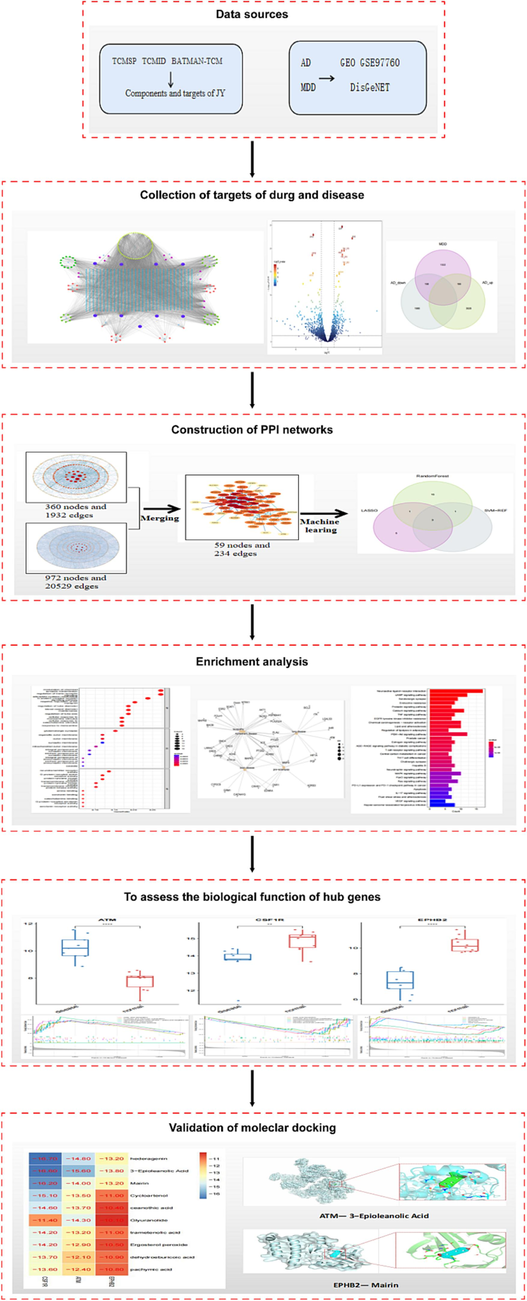
Workflow for Jieyu Anshen Granules (JY) treatment of Comorbidity With Alzheimer's Disease and Depression.
2 Method
2.1 Screening and identification of the active ingredients of JY
The Traditional Chinese Medicine Systems Pharmacology Database and Analysis Platform (TCMSP) (https://tcmspw.com/) and the Traditional Chinese Medicine Integrated Database.
(TCMID) (https://www.megabionet.org/tcmid/) are comprehensive pharmacological platform specifically designed for Chinese herbal medicines, emphasizing the role of systemic pharmacology in Chinese medicine (Ru et al., 2014, Huang et al., 2018). To identify the active ingredients of JY, we searched the TCMSP database using the keywords “Baihe”, “Chai Hu”, “Baishu”, “Suanzaoren”, “Zhizi”, “Dazao”, “Nanxin”, “Dangui”, “Fulin”, “Banxia”, “Shichangpu”, “Yu Jin” and “Gancao”.The TCMID database was used to search for additional active ingredients and screen for compounds with high activity within the JY formulation using keywords “Fuxiaomai”, “Yuanzhi” and “Longchi”. The active ingredients of all databases were imported into the TCMSP for screening, the screening criteria were an Oral Bioavailability (OB) ≥ 30 % and a Drug Trad (DL) ≥ 0.18.
2.2 Collection of drug component-related targets
After screening the active ingredients of the JY formulation, the corresponding targets were further identified. SwissTargetPrediction (http://www.swisstargetprediction.ch/) is a tool for predicting compound targets by assessing similarities to the 2D and 3D structures of known compounds (Daina et al., 2019). The PubChem organic small molecule bioactivity database (https://pubchem.ncbi.nlm.nih.gov) was used to retrieve the molecular structure of each active ingredient in JY formulation, then the SMILES formula of each active ingredient was obtained and inputted into SwissTargetPrediction to identify and collect potential targets associated with the active ingredients. The screening condition was “Probability* ≥ 0.1″ (Kim et al., 2021). Furthermore, a herbal compound-target network representing the JY formulation was constructed and visualized using the Cytoscape 3.8.2 software, in which nodes were used to represent herbs, ingredients, and targets, while the edges represent their interactions.
2.3 Collection, identification and analysis of differentially expressed genes in Alzheimer's disease
Microarray data for the GSE97760 dataset was downloaded from the GEO database (https://www.ncbi.nlm.nih.gov/geo/) using its microarray platform GPL16699 (Agilent-039494 SurePrint G3 Human GE v2 8x60K Microarray 039381). The GSE97760 dataset contains 9 AD peripheral blood samples and 10 normal samples. The probes were converted to gene symbols based on the annotation information specific to the microarray platform, duplicate genes and probes were removed, and the limma package of R software (version 4.2.1) was used to identify and screen DEGs between the AD and normal groups. Genes with symbols containing “LOC”, “LROC” and “XLOC” were excluded from the analysis. DEGs with a p-value less than 0.05 and |logFC| ≥ 1 were then visualized using volcano plots.
2.4 Collection of differential genes for depression disease targets and AD taken at intersection
DisGeNET (https://www.disgenet.org) is a comprehensive database of genes associated with human diseases (Piñero et al., 2017), encompassing a vast collection of information on the molecular basis of specific diseases, annotation of genomic lists, sequencing protocols derived from various gene types, validation of disease gene prediction methods, and exploration of disease comorbidities. Here, the DisGeNET database was used to search for target genes related to depression, using the keyword “Depressive disorder” and the disease ID: C0011581. Lastly, we screened for overlapping genes associated with depression from AD differential genes.
2.5 Construction of protein–protein interaction networks
To investigate protein–protein interactions (PPIs) between protein-coding genes, we constructed a PPI network using the STRING database (http://string-db.org), with a confidence score set at 0.7 (Piñero et al., 2017). Drug targets and disease targets were separately imported into the website to obtain PPI network data, which were further analyzed using Cytoscape 3.8.2. The two PPI networks were merged into a new network using Cytoscape's merge tool. Next, we used the CytoNCA plugin (Tang et al., 2015) to identify hub genes and core networks. The pivotal genes were selected based on parameters such as degree centrality (DC), betweenness centrality (BC), and closeness centrality (CC). Finally, the core network of JY for AD and MDD comorbidities was obtained, and genes in the PPI network that could interact with each other were selected for subsequent analysis.
2.6 Functional enrichment analysis
GO enrichment analysis, including the assessment of biological process (BP), cellular component (CC) and molecular function (MF) terms, was conducted using the ClsterProfifiler package in R software (Yu et al., 2012). KEGG pathway enrichment analysis was also performed using the ClsterProfifiler package (v3.16.0). Bubble plots were generated using the ggplot2 R package to visualize the top 10 significant KEGG pathways based on a p. adjustment < 0.05. The top 10 results for BP, CC and MF in the GO enrichment (p.adjusted < 0.05) were sorted from smallest to largest, and the GO plot R package (v1.0.2) was used to create bubble plots representing the selected top 10 terms for each category. For the first 5 terms, a sub-network was created in Cytoscape 3.8.2 to visualize the relationship between the genes and their corresponding GO terms.
2.7 Further screening of core genes based on machine learning algorithms
To further identify hub genes, three machine learning algorithms (SVM, RF and LASSO) were employed to construct classification models. LASSO is a regression method that enhances prediction accuracy and improves the comprehensibility of statistical models by selecting variables through variable selection and regularization techniques (Alhamzawi and Ali, 2018). RF (Rigatti, 2017) is an integrated learning algorithm that combines different decision trees, has no restrictions on variable conditions and offers better accuracy, sensitivity and specificity for predicting continuous variables. The SVM-RFE algorithm (Sanz et al., 2018) is a versatile machine learning method specifically designed to address challenges such as small sample sizes and non-linearity. It demonstrates strong generalization capabilities by training the model using labeled training samples and subsequently classifying test samples based on the optimal hyperplane.
The GSE97760 dataset was randomly divided, with 80 % of the samples used as the training dataset. Supporting vector machine, RF and LASSO classification models were constructed using the e1071 package (Cinelli et al., 2017), random Forest package and glm function, respectively. The samples were classified into cases and controls according to gene expression levels. Internal and external validation was performed to confirm the stability and reproducibility of these constructed classifiers. Internal validation was performed on the remaining 20 % of samples GSE97760. The validity of the model was then comprehensively evaluated in terms of sensitivity (Se), specificity (Sp), positive predictive value (PPV), negative predictive value (NPV) and area under the ROC curve (AUC). All statistical analyses were performed using the R 4.2.2 software. Lastly, overlapping genes between potential genes generated by the LASSO, SVM-RFE and RF algorithms were considered as common disease-drug key genes.
2.8 Assessment of the expression levels and diagnostic significance of potential biomarkers
Column line graphs are valuable tools in clinical diagnosis and were constructed using the “rms” R package based on candidate genes. ROC curves were used to assess the performance of classifiers in bioinformatics (Hajian-Tilaki, 2013). To further evaluate the accuracy of hub genes in prediction, ROC curves were generated using the pROC package in R based on the expression profiles of high-throughput sequencing data (GSE1297, GSE97760 and GSE98793). The diagnostic value of the hub gene was compared by measuring the area under the ROC curve and the AUC.
2.9 The biological function of potential biomarkers
To further investigate the biological functions of ATM, CSF1R and EPHB2, we used Gene Set Enrichment Analysis (GSEA) to understand the functions of the pivotal genes. GSEA (Canzler and Hackermüller, 2020) was performed using the Cluster Analyzer R package to investigate the biological function of potential biomarkers through an ordered gene expression matrix based on the correlation between each biomarker and other genes.
2.10 Molecular docking validation and molecular dynamics simulations
To investigate the detailed docking patterns and binding affinities between macromolecules and small molecules (ligands), we performed molecular docking based on molecular modeling techniques using the AutoDock software. Then, the direct-acting targets in the core network and their corresponding bioactive components were identified. The x-ray crystal structures of key targets were obtained from the RCSB Protein Data Bank (PDB, https://www.rcsb.org/) and stored in PDB format. The MOL2 format of the bioactive components was downloaded from the ZINC database (https://zinc.docking.org/). Prior to molecular docking, we used the AutoDock software (version 4.2.6) to remove ligands, hydrogenate, calculate charges and add protein types of macromolecules, which were then saved in PDBQT format. Then, AutoDock was used to perform molecular docking between the macromolecule and the ligand using default parameters. A binding affinity value less than “-5″ indicated better a stronger binding interaction between the macromolecule and the small molecule. Lastly, molecular docking was performed using the PyMOL software (version 2.4.1) (Seeliger and de Groot, 2010).
3 Results
3.1 The active ingredient and active target of JY
The TCMSP and TCMID databases were used to screen for active ingredients of JY, using the criteria OB ≥ 30 % and DL ≥ 0.18. A total of 171 active ingredients were selected as candidate bioactive ingredients. The detailed IDs, molecular names, OB, DL values and compound structures of the bioactive ingredients are shown in Supplementary Table S1. Interestingly, it was observed that these different drugs shared common active ingredients (Supplementary Table S2). Analysis of the drug library database (SwissTargetPrediction) using the candidate bioactive ingredients showed that 979 targets were associated with the ingredients after removing duplicate values. The specific ingredient-target information is shown in Supplementary Table S3.
3.2 Building drug-component-target networks
Using the Cytoscape software, we built a network to illustrate the relationships among herbs, ingredients and putative targets (Fig. 2). This component-target network contains 1145 nodes and 8815 edges. The results showed that Poria nilotic acid was the most abundant, with 136 potential targets, followed by kaempferol (potential targets, 100) and ethyl linoleate (potential targets, 100).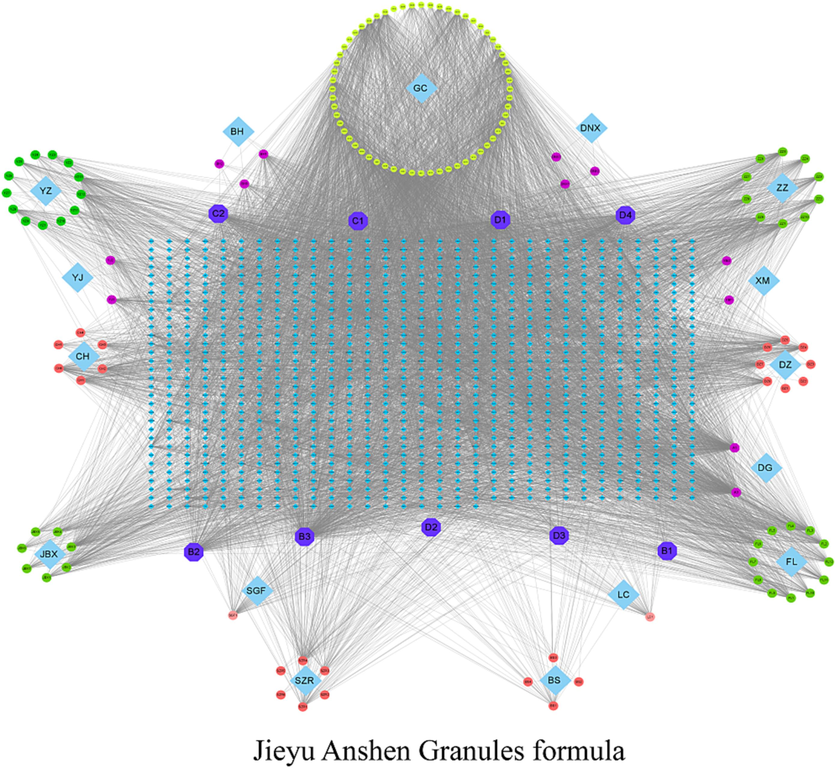
Herb-Ingredient-target network of JY. Blue rhombus represents herb, the circular represents ingredients, Dark blue octagon represents targets.
3.3 Identification of differentially expressed genes associated with Alzheimer's disease
The AD expression dataset was downloaded, and DEGs were selected by comparing gene expression levels between control and AD samples. Using the limma package in R software, we identified a total of 5411 DEGs from the GSE97760 dataset. The cut-off criteria for DEGs’ selection were p < 0.05 and |log2 FC| > 1. Among these, 2184 DEGs were visualized in the volcano plot (Fig. 3A). The detailed information on DEGs associated with AD are shown in Supplementary Table S4.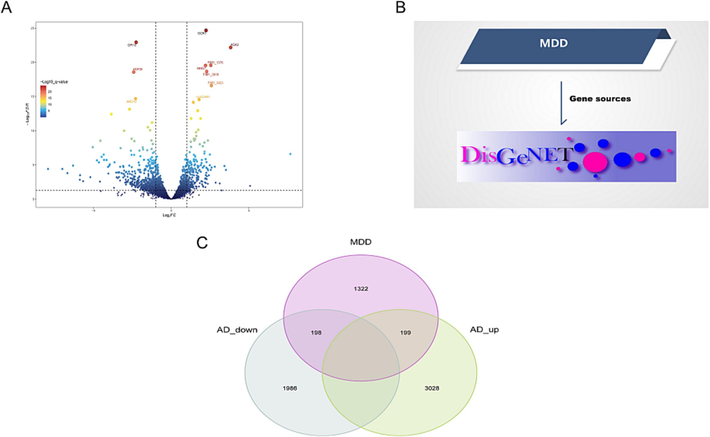
Identification of differentially expressed genes (DEGs) shared between AD and MDD. Volcano plot of differentially expressed genes in AD (A). The red dots represent significantly up-regulated genes, and the green dots represent significantly down-regulated genes. The DisGeNET database was used to search for target genes related to MDD (B). The overlapped differentially expressed genes of AD and MDD were selected (C).
3.4 DEGs in depression and Alzheimer's disease
The DisGeNET database was utilized to retrieve genes and relevant target details for depression (Fig. 3B; Supplementary Table S5), resulting in a total of 1719 relevant targets. Overlapping genes associated with depression were identified by comparing them with the differential genes in AD and visualized via Venn diagrams using R software (Fig. 3C). Among the overlapping genes, 397 genes were shared between AD and MDD, among which 199 were up-regulated and 198 were down-regulated. Next, we used the STRING database to construct the PPI network for AD and depression common targets. As shown in Fig. 4A, the PPI network for AD complicated with depression-related targets consisted of 1932 edges and 360 nodes.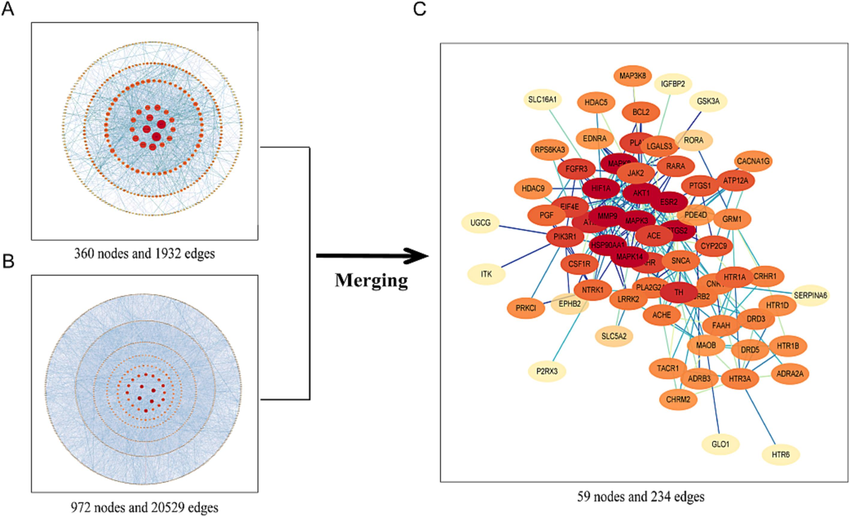
Identification of core network and targets of JY against AD with MDD. AD comorbidity MDD-related targets PPI network (A). JY putative targets PPI network (B). PPI network of candidate JY targets for AD comorbidity MDD treatment extracted from Panel (C).
3.5 Merging and analysis of protein–protein interaction networks
Using the STRING database, we constructed a PPI network for the putative targets related to JY. The PPI network was constructed with a PPI enrichment p-value < 1.0e-16 and a minimum required interaction score of 0.400. The resulting network comprised 20,529 edges and 972 nodes (Fig. 4B). Next, we imported the PPI networks of disease (Supplementary Table S6) and drug targets (Supplementary Table S7) into the Cytoscape software, and using its Merge-intersection tool, we performed an intersection merging of the networks, which resulted in a new merged network representing the interactions between JY and the comorbidities of AD and MDD and comprising 59 targets and 234 edges, and adjusted the note size and the edge connectivity thickness through node degree and combined_score (Fig. 4C).
3.6 Enrichment analysis of core targets
To investigate the biological mechanisms of the 57 key targets, we performed DO, GO and KEGG enrichment analysis using the clustering profile package in R. DO enrichment analysis revealed that the identified targets were strongly associated with Alzheimer's disease (AD) and encephalopathy (Fig. 5B). Further, GO enrichment analysis identified a total of 1185 BPs, 29 CCs, and 90 MFs, as well as 122 significantly enriched KEGG pathways (p < 0.05) (Supplementary Tables S8 and S9). The GO pathways showed significant enrichment in BPs related to the regulation of chemical synaptic transmission, trans-synaptic signaling, adenylate cyclase regulation of G protein-coupled receptor signaling pathway, negative regulation of ion transport, cellular responses to monoamine stimulation, and responses to monoamines (Fig. 5A). The enriched CC pathways included glutamatergic synapses, organelle outer membranes, outer membranes, synaptic membranes, and components of synaptic membranes. In terms of MF, the enriched pathways included neurotransmitter receptor activity, G protein-coupled amine receptor activity, protein tyrosine kinase activity, transmembrane receptor protein tyrosine kinase activity, transmembrane protein kinase activity, amine binding, and catecholamine binding. Furthermore, the KEGG pathway analysis revealed the involvement of various pathways, including the cAMP signaling pathway, PI3K-Akt signaling pathway, calcium signaling pathway, 5-hydroxytryptaminergic pathway, TNF signaling pathway, neurotrophin signaling pathway, MAPK signaling pathway and Ras signaling pathway, in the treatment of AD and MDD comorbidity with JY (Fig. 5C).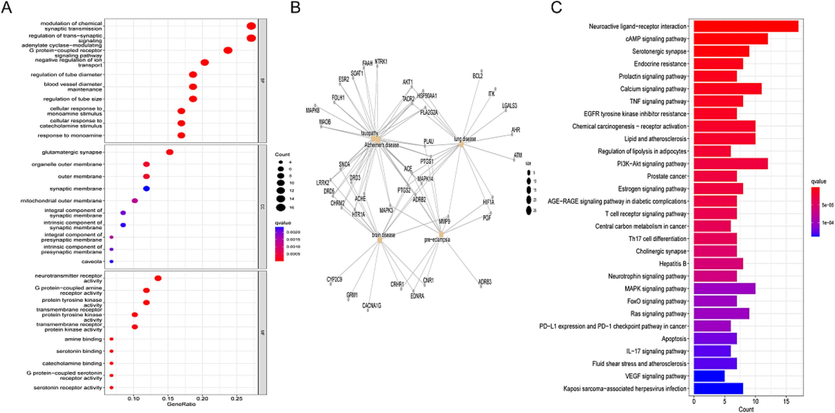
Functional enrichment analysis. The top 10(BP、CC、MF)terms of GO analysis about targets involved in the core network (A);DO analysis about targets involved in the core network (B);The top 30 KEGG pathway enrichment of core targets of JY against AD comorbidity MDD (C). Pathways that had significant changes of p. adjust < 0.05 were identified. The dot size represents a number of genes and color represents the p. adjust value.
3.7 Identifying core genes by machine learning
To identify potential biomarkers among the 57 target genes, we used LASSO regression, SVM-RFE, and random forest algorithms. In the LASSO regression model, we performed λ analysis and determined that the model accurately predicted the disease using λ = 3. Based on this lambda value, we obtained the LASSO regression coefficient profiles of potential genes (Fig. 6A-B). From these profiles, we identified 9 signature genes: EPHB2, NTRK1, HTR1A, CSF1R, ADRA2A, BRS3, JAK2, HDAC9, and ATM. The coefficient values and additional details of these potential genes are shown in Supplementary Table S10. Next, we used the SVM-RFE algorithm and constructed an SVM model based on 4 signature genes, which showed that it had a best error rate of 0 and an accuracy rate of 1 (Fig. 6C–D). SVM-RFE analysis was performed to obtain the average ranking of each algorithm (Supplementary Table S11), and the RF algorithm was used to rank the genes according to their importance (Fig. 6E–F), based on which we selected the top 25 most important genes in RF (Supplementary Table S12). Finally, the intersection of potential candidate genes in the three algorithms was visualized using a Venn diagram (Fig. 6G), and three intersecting genes (ATM, CSF1R and EPHB2) were identified and further validated in subsequent steps.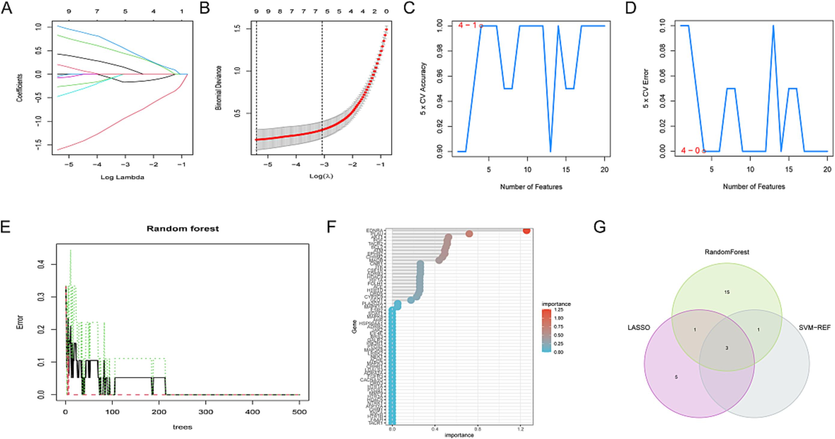
Identifying candidate diagnostic biomarkers for AD and MDD comorbidities by machine learning. Biomarkers screened in the Lasso model(A, B). The number of genes (n = 9) corresponding to the lowest point of the curve is the most suitable for disease(C, D). Biomarkers were screened in the SVM − RFE algorithm, and the SVM model based on four signature genes had the best error rate of 0 and an accuracy rate of 1 (E, F). The random forest algorithm showed the error in disease; control group and genes are ranked based on the importance score. Venn diagram shows that 3 candidate diagnostic genes are identified via the above three algorithms(G).
3.8 To assess their expression levels and biological function for potential biomarkers
To further verify the role of ATM, CSF1R and EPHB2, we examined their expression levels in the AD databases GSE97760 and GSE1297 (22 AD hippocampal tissues and 9 normal samples) and the MDD database GSE98793 (128 MDD peripheral blood samples and 64 normal samples). Our analysis revealed that ATM was up-regulated, while CSF1R and EPHB2 were down-regulated compared to the control group(p<0.05) (Fig. 8A–C). Furthermore, we constructed column line plots based on the three candidate genes (Fig. 7A) and generated ROC curves to assess the diagnostic specificity and sensitivity of each gene in the aforementioned databases. The AUC values of all candidate genes were high, indicating their strong diagnostic value (Fig. 7B–G). Notably, the column line plots had the highest diagnostic value. Fig. 8D–F illustrated the biological processes and components associated with the up-regulation of ATM expression and the down-regulation of CSF1R and EPHB2 expression, which included the pentose phosphate pathway, nitrogen metabolism, fructose and mannose metabolism, fatty acid elongation, ribosomal components, and GPI-biosynthetic pathways.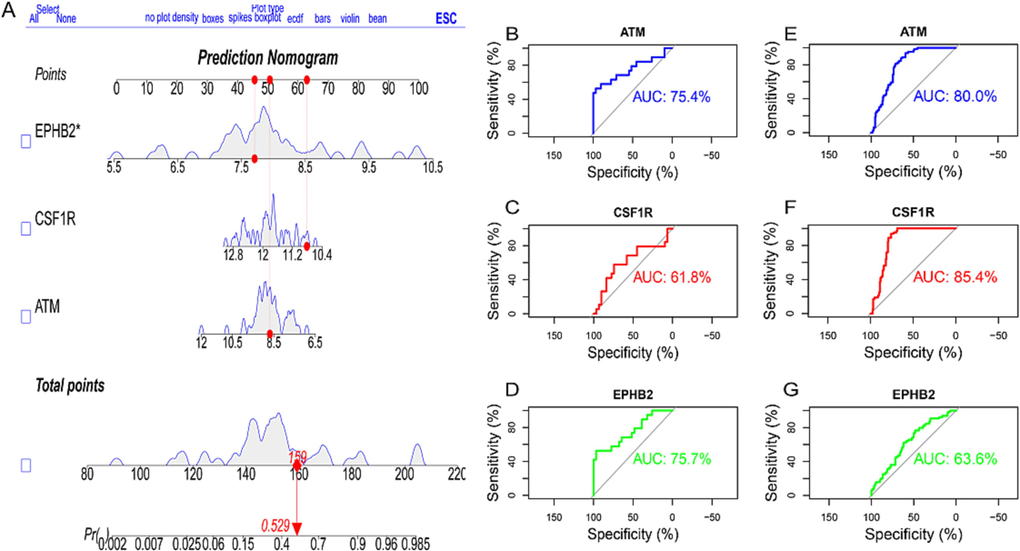
The expression levels and diagnostic implications of the potential biomarkers. Nomogram construction and the diagnostic value evaluation. The visible nomogram(A); The ROC curve of each candidate gene (ATM, CSF1R, and EPHB2) show the significance with diagnostic value for diagnosing both AD (B-D) and MDD(E-G).
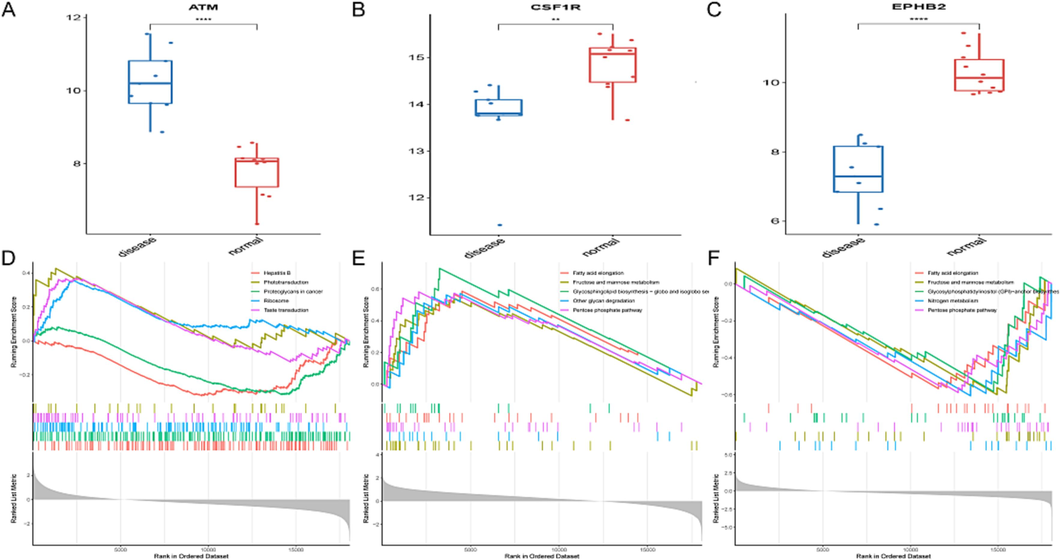
The expression levels of ATM, CSF1R, and EPHB2 in disease(A-C). GSEA of potential biomarkers: KEGG results for ATM(D); KEGG results for CSF1R(E); KEGG results for EPHB2(F).
3.9 Validation of molecular docking
The PPI network analysis identified ATM, CSF1R and EPHB2 as key targets within the core network, which were also overlapping genes for AD and MDD comorbidities. To validate their interactions, molecular docking was performed using their corresponding bioactive components as ligands. The ligand-receptor binding conformations had the lowest binding energy, indicating that it was the most stable and the most likely to interact. Hederagenin showed a good binding affinity with all three target receptors, with binding energies of −16.7, −14.0.8 and −13.2 kcal/mol, respectively. The binding energies of 3-Epioleanolic acid and the three targets were −16.6, −15.6 and −13.8 kcal/mol, respectively. Notably, CSF1R showed the highest binding affinity for each of the small molecule ligands. Additional specific docking scores of these components to the targets are shown in Supplementary Table S13, and the top-ranked binding targets are illustrated on the heat map shown in Fig. 9A. 3D view of the docking pattern between the components and targets for the top 4 rankings was constructed using PyMOL (Fig. 9B–G).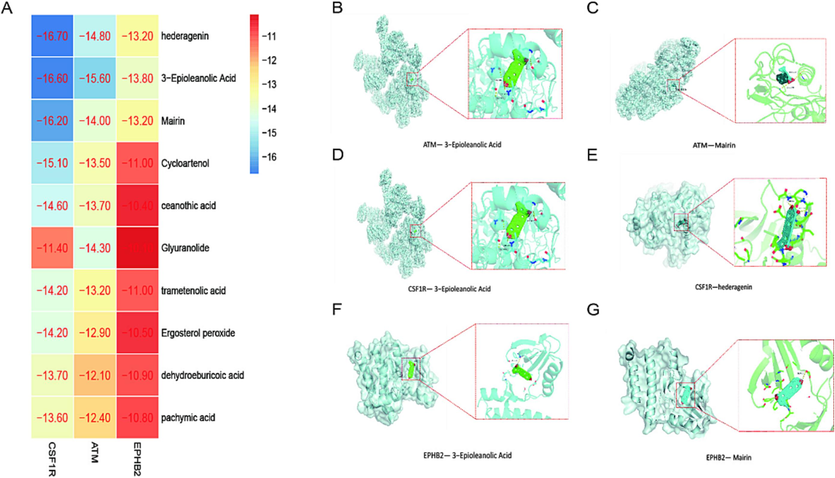
Docking binding Energy of key targets and main active components (Kcal/Mol). The molecular docking results of key targets and their corresponding ingredients(A), ATM binding 3 − Epioleanolic Acid(B); ATM binding Mairin (C); Interaction between CSF1R protein and 3 − Epioleanolic Acid (D); CSF1R binding hederagenin(E); EPHB2 binding 3 − Epioleanolic Acid(F); EPHB2 binding Mairin(G).
4 Discussion
Depression commonly coexists with Alzheimer's disease (AD) (Lyketsos et al., 2011), but the underlying pathophysiological mechanisms connecting the two conditions remain unclear (Harerimana et al., 2022). Selective serotonin reuptake inhibitors (SSRIs) are frequently prescribed for treating depression in AD patients (Elsworthy and Aldred, 2019). However, due to the multifactorial nature of the diseases, a significant proportion of patients do not respond well to these antidepressants (Veitch et al., 2022). Furthermore, SSRIs are associated with various side effects, such as sexual dysfunction, hypertension, sleep and gastrointestinal disorders, extrapyramidal symptoms, and an increased risk of fracture (Nitzan et al., 2022). Therefore, there is a need to discover new antidepressants that are effective and have minimal side effects to enhance treatment options. In this context, natural compounds derived from medicinal plants have gained increasing attention worldwide due to their lower toxicity, fewer adverse events, and better patient adherence (Jasib Habeeb et al., 2022) Depression is considered a common complication of AD and significantly impacts the treatment of AD patients (Cacabelos et al., 2023). Hence, developing an effective treatment for patients with AD and MDD comorbidities is of utmost importance (Yang et al., 2020). Xie Yu An Shen Granules, a traditional Chinese medicine formulation, or its main ingredients, have been widely used for the treatment of depression with notable clinical effects (Du et al., 2020). In this study, we employed a combination of network pharmacology and bioinformatic analysis to investigate the potential mechanisms underlying the therapeutic effects of Xie Yu An Shen Granules in patients with AD and MDD comorbidities.
In this study, we constructed PPI networks between the targets of JY components and patients with AD combined with MDD. Through merging and topological analysis, we identified 57 potential targets involved in the therapeutic effects of JY for these patients. KEGG pathway analysis showed that these core targets mainly interacted with the cAMP signaling pathway, PI3K/Akt signaling pathway, calcium signaling pathway, 5-hydroxytryptaminergic, TNF signaling pathway, etc., reflecting the shared pathogenesis between AD and MDD. Consistent with the results of KEGG analysis, the main pathways including PI3K/Akt signaling pathway, cAMP signaling pathway, calcium signaling pathway and TNF signaling pathway have been reported in the literature to be both involved in the development of AD and to play an important role in depression, and modulating these pathways may ameliorate the progression of AD and MDD comorbidities. It was shown that activation of the PI3K / Akt signalling axis in neurons could exert anti-AD and antidepressant effects by reducing Tau hyperphosphorylation as well as serotonergic neurotransmission (Pehrson et al., 2022).Similarly, the cAMP signaling pathway is implicated in various processes such as neurofibrillary tangle formation, synapse reduction, neuronal apoptosis, and neuroinflammation (Zhu et al., 2020). Previous studies found that cAMP could mediate the activation of downstream molecules PKA-CREB-BDNF to ameliorate spatial learning and memory deficits in depressed rats (Luo et al., 2017). The calcium signaling pathway has also garnered significant attention in AD and MDD research. Calcium channels are involved in multiple signaling pathways that regulate mitochondrial function, oxidative stress, tau phosphorylation, and memory formation. Stimulation of calcium signaling through N-methyl-D-aspartate-receptor (NMDAR) and/or AMPA-type glutamate receptor(AMPAR) activation triggers downstream pathways that contribute to both depressive and antidepressant effects (Shen et al., 2021). The neurotransmitter pathways in the hippocampus (5-hydroxytryptaminergic and glutamatergic synapses) also play a crucial role in the underlying molecular mechanisms of depression, providing useful clues for identifying a detailed depression-related metabolic profile (Nowak et al., 2019). Lastly, glial activation and neuroinflammation are implicated in the pathogenesis and progression of AD, with the TNF signaling pathway being critical. Increased expression of multiple proteins involved in the TNF/TNF receptor-1-mediated necroptotic pathway has been observed in the brains of individuals with AD (Hei et al., 2019). Overall, the PPI networks and enrichment analyses revealed that JY might modulate key signaling pathways, including the cAMP signaling pathway, calcium signaling pathway, PI3K/Akt signaling pathway, and TNF signaling pathway, to improve AD and MDD comorbidities.
Next, using machine learning, we identified three key genes (ATM, CSF1R, EPHB2) that may play crucial roles in the development of AD and MDD comorbidities. ATM is a central regulator of the DNA damage response, involved in DNA damage repair, cell cycle arrest, and apoptosis (Gao et al., 2021). Deletion of ATM proteins in vulnerable neuronal populations can lead to loss of cell cycle control and cell death (Shen et al., 2016). In recent years, studies have increasingly focused on the DNA damage response in AD and MDD, but the mechanisms are not yet clear. ATM may promote neuronal apoptosis in response to DNA damage through pathways such as p53-E2F-1 and MAPK-IKK-NF-kappaB (Hu et al., 2021, Jayaraman et al., 2021). Additionally, experimental ATM inhibitors are being investigated for the treatment of neurodegenerative diseases (Hu et al., 2021). In summary, the potential use of ATM inhibitors could be a promising therapeutic approach in AD. However, due to limited understanding of the relevant pathways and mechanisms of action of ATM, further investigations are needed to uncover the specific mechanisms by which ATM might be involved in depression. The colony-stimulating factor 1 receptor (CSF1R), a product of the proto-oncogene c-fms, belongs to the class III transmembrane tyrosine kinase receptor family. It regulates microglia homeostasis, neurogenesis and neuronal survival in the central nervous system (CNS), and its dysfunction has been associated with several diseases, including AD and MDD (Hu et al., 2021). Previous studies have shown that the inhibition of CSF1R could eliminate microglia in 3xTg-AD and 5XFAD model mice, inhibition of CSF1R at lower levels prevented microglia-plaque association and improved cognition, and early long-term administration of CSF1R inhibitors PLX3397 and PLX5622 ablated microglia and reduced intra-neuronal amyloid, neuritis plaque deposits and profibrillary oligomers accumulation in AD mouse models (Dagher et al., 2015, Sosna et al., 2018). Consistent with the above studies, CSF1R expression was reduced in our AD samples. Previous studies have shown a down-regulation of CSF1R expression in post-mortem samples (parietal cortex, cerebellum) from depressed patients, which regulated microglia/macrophage proliferation, differentiation and survival (Zhang et al., 2020). Pharmacological experiments also suggested that Jiao Tai Wan (JTW), a herbal formulation for the treatment of depression, could ameliorate CORT-induced neuronal damage in depressed mice by inhibiting CSF1R-mediated microglia activation and pro-inflammatory responses (Bai et al., 2022). EPHB2, a member of the receptor tyrosine kinase family, plays a crucial role in various neurological processes such as cell adhesion, neural crest migration, axon guidance, and synaptogenesis within the nervous system (Qu et al., 2013). Recent studies have demonstrated that preserving EPHB2 in transgenic mouse models of AD can rescue cognitive deficits, and overexpression of EphB2 can improve impaired memory in APP/PS1 transgenic mice (Hu et al., 2017). EphB2 overexpression has also been shown to protect hippocampal neurons from neurotoxicity induced by Aβ1-42 oligomers, potentially by increasing synaptic NMDA receptor levels and activating downstream p38 MAPK and CREB signalling (Geng et al., 2013). Furthermore, EphB2 is involved in the development of neurogenic regions in excitatory neurons, suggesting that its inactivation may contribute to neuropsychiatric disorders, including depression and memory impairment. Studies have demonstrated that EphB2 can prevent the progression of depression-like behavior and memory impairment by downregulating the NMDA-2B receptor (Zhen et al., 2018). Additionally, in previous investigations using proteomic and metabolomic sequencing of the hypothalamus in LPS-induced depressed mice, elevated levels of EPHB2 were observed, and it interacted with the NMDAR subunit GluN2A, which accumulated in the hypothalamus, indicating that targeting the EPHB2-GluN2A-AKT cascade could be a potential therapeutic strategy to correct glutamatergic transmission dysfunction associated with depression (Wu et al., 2019). Thus, ATM, CSF1R and EphB2 might be involved in the common pathogenesis of AD and depression and represent key targets for intervention with JY.
In this study, we conducted molecular docking to compare the key targets with the bioactive components of JY. Among the 104 components screened, betulinic acid (Mairin), hederagenin, and 3-Epioleanolic Acid were found to bind well to multiple key targets. Mairin, a biologically active pentacyclic tricyclic triterpenoid, is primarily found in the fruit bark, leaves, and stem bark of Betula spp (Cho et al., 2016). It possesses the ability to penetrate the blood–brain barrier and has a long elimination half-life. Mairin exhibits anti-inflammatory and antioxidant effects and has been shown to stimulate the production of neurotoxic reactive oxygen species (ROS) in macrophages and astrocytes, thereby inhibiting lipid peroxidation (Dubey and Chinnathambi, 2019). It has been demonstrated to attenuate cognitive decline associated with AD by protecting against neuronal damage in animal models of polyamine-induced amnesia and STZ-induced rat brain. Mairin is a key active ingredient in several anti-AD drugs, including Shankhpushpi, Brahmi, and Ellagic acid, among others (Kaundal et al., 2018a, 2018b). Previous studies have demonstrated that Mairin acts as a natural inhibitor of Phosphodiesterase 4 (PDE4) through the cAMP/cGMP and BDNF pathways, leading to improved cerebral blood flow and restoration of memory deficits in animal models of vascular dementia (Kaundal et al., 2018a, 2018b). Additionally, Daniele G. Machado et al. found that the antidepressant potential of Rosmarinus officinalis L was mainly attributed to the presence of Mairin (Machado et al., 2013). Hederagenin is a triterpene saponin extracted from red fruit and exhibits anti-apoptotic, hypolipidemic, and anti-inflammatory properties (Lu et al., 2015). Previous research has shown that hederagenin can prevent the decrease in mitochondrial membrane potential, reduce intracellular production of reactive oxygen species (ROS), inhibit corticosterone-induced apoptosis, and protect PC12 cells from corticosterone-induced damage by activating the PI3K/AKT pathway (Lin et al., 2021). It has also demonstrated the ability to effectively reduce brain levels of Aβ and tau in APP/PS1 double transgenic mice, thereby alleviating cognitive impairment (Chowdhury et al., 2017). Previous studies have indicated that hederagenin enhances central monoamine signaling pathways by inhibiting the reuptake of extracellular monoamines such as 5-HT, noradrenaline, and dopamine, suggesting that this mechanism may contribute to its antidepressant activity (Wang et al., 2019). In network pharmacology studies focusing on the co-morbid treatment of AD and MDD, hederagenin has been identified as a significant component that exhibits polypharmacological and synergistic effects (Zhang et al., 2021). Additionally, 3-Epioleanolic acid is an active ingredient derived from Verbena officinalis and exhibits anti-inflammatory activity (Truong et al., 2011). It is worth noting that 3-Epioleanolic acid obtained from Gardenia jasminoides fruit has been suggested to play a key role in the stimulation of Glucagon-like peptide-1 (GLP-1) secretion (Luo et al., 2020). Previous studies have indicated its involvement in smooth muscle contraction through the mediation of cholinergic receptors as a chemical component of E. capensis (Sewram et al., 2000). However, no experimental evidence currently supports its potential cognitive improvement and antidepressant biological functions, which require further exploration. Taken together, we identified a trio of pivotal genes with promising diagnostic properties that could be considered potential targets for developing anti-AD and antidepressant drugs. Molecular docking has shown that the active components of JY, Mairin, hederagenin and 3-Epioleanolic Acid, can protect AD and MDD comorbidities by acting on ATM, CSF1R and EPHB2. Our findings also suggest that ATM, CSF1R, and EPHB2 may serve as common targets for treating AD and MDD comorbidities.
5 Conclusions
In this study, an integrated network pharmacology and comprehensive bioinformatics approach were employed to investigate the potential mechanisms and molecular targets of JY in the treatment of AD combined with depression. Our findings suggest that JY may act on the cAMP, calcium, and PI3K-Akt signaling pathways. Furthermore, the study identified ATM, CSF1R, and EPHB2 as key targets of JY for the treatment of AD complicated with depression, supporting the potential of JY as a promising and safe multi-targeted treatment in this disease.
Authorship contribution statement
X.R. and S.W. prepared the manuscript and were participated in the data analysis; Y.W. and C.L. conducted the literature research; M.Y. and J.J.Z. were involved in the data analysis; S.Y.L. collected data; X.W.Z. and L.W. guided the data analysis; S.W. and X.R. reviewed and edited the manuscript. All authors read and approved the final manuscript.
Acknowledgement
We gratefully acknowledge the technical support and helpful discussions of our colleagues and collaborators.
Funding information
This work was supported by Hebei Natural Science Foundation [grant numbers: C2020206041], National Natural Science Foundation [grant number:82101378] and the Key Project of Hebei Medical Science Research [grant number:20210309].
Declaration of competing interest
The authors declare that they have no known competing financial interests or personal relationships that could have appeared to influence the work reported in this paper.
References
- Anti-depressive effects of Jiao-Tai-Wan on CORT-induced depression in mice by inhibiting inflammation and microglia activation. J. Ethnopharmacol.. 2022;283:114717
- [CrossRef] [Google Scholar]
- Anxiety and depression in Alzheimer's disease: a systematic review of pathogenetic mechanisms and relation to cognitive decline. Neurol. Sci.. 2022;43:4107-4124.
- [CrossRef] [Google Scholar]
- Pharmacogenetics of anxiety and depression in Alzheimer's disease. Pharmacogenomics. 2023;24:27-57.
- [CrossRef] [Google Scholar]
- multiGSEA: a GSEA-based pathway enrichment analysis for multi-omics data. BMC Bioinf.. 2020;21:561.
- [CrossRef] [Google Scholar]
- Neurobiological links between depression and AD: The role of TGF-β1 signaling as a new pharmacological target. Pharmacol. Res.. 2018;130:374-384.
- [CrossRef] [Google Scholar]
- Ameliorative effect of betulin from Betula platyphylla bark on scopolamine-induced amnesic mice. Biosci. Biotech. Bioch.. 2016;80:166-171.
- [CrossRef] [Google Scholar]
- Oleanane triterpenoids from Akebiae Caulis exhibit inhibitory effects on Aβ42 induced fibrillogenesis. Arch. Pharm. Res.. 2017;40:318-327.
- [CrossRef] [Google Scholar]
- Feature selection using a one dimensional naïve Bayes' classifier increases the accuracy of support vector machine classification of CDR3 repertoires. Bioinformatics. 2017;33:951-955.
- [CrossRef] [Google Scholar]
- Alzheimer's disease: insights from a network medicine perspective. Sci. Rep.. 2022;12:16846.
- [CrossRef] [Google Scholar]
- Colony-stimulating factor 1 receptor inhibition prevents microglial plaque association and improves cognition in 3xTg-AD mice. J. Neuroinflammation. 2015;12:139.
- [CrossRef] [Google Scholar]
- SwissTargetPrediction: updated data and new features for efficient prediction of protein targets of small molecules. Nucleic Acids Res.. 2019;47:W357-W364.
- [CrossRef] [Google Scholar]
- Stress-Induced depression and Alzheimer's disease: focus on astrocytes. Int. J. Mol. Sci.. 2022;23
- [CrossRef] [Google Scholar]
- Jieyu Anshen Granule, a Chinese herbal formulation, exerts effects on poststroke depression in rats. Evid. Based Complement. Alternat. Med. 20207469068
- [CrossRef] [Google Scholar]
- Brahmi (Bacopa monnieri): an ayurvedic herb against the Alzheimer's disease. Arch. Biochem. Biophys.. 2019;676:108153
- [CrossRef] [Google Scholar]
- Depression in Alzheimer's disease: an alternative role for selective serotonin reuptake inhibitors? J. Alzheimers Dis.. 2019;69:651-661.
- [CrossRef] [Google Scholar]
- Metabolomic analysis of the hippocampus in a rat model of chronic mild unpredictable stress-induced depression based on a pathway crosstalk and network module approach. J. Pharm. Biomed. Anal.. 2021;193:113755
- [CrossRef] [Google Scholar]
- Protective effects of EphB2 on Aβ1-42 oligomer-induced neurotoxicity and synaptic NMDA receptor signaling in hippocampal neurons. Neurochem. Int.. 2013;63:283-290.
- [CrossRef] [Google Scholar]
- Receiver Operating Characteristic (ROC) curve analysis for medical diagnostic test evaluation. Caspian J. Intern Med.. 2013;4:627-635.
- [Google Scholar]
- Cognitive impairment and neurocognitive profiles in major depression-A clinical perspective. Front. Psychiatry. 2022;13:764374
- [CrossRef] [Google Scholar]
- Genetic evidence supporting a causal role of depression in Alzheimer's disease. Biol. Psychiatry. 2022;92:25-33.
- [CrossRef] [Google Scholar]
- Effects of chronic mild stress induced depression on synaptic plasticity in mouse hippocampus. Behav. Brain Res.. 2019;365:26-35.
- [CrossRef] [Google Scholar]
- Insights into the role of CSF1R in the central nervous system and neurological disorders. Front. Aging Neurosci.. 2021;13:789834
- [CrossRef] [Google Scholar]
- Overexpression of EphB2 in hippocampus rescues impaired NMDA receptors trafficking and cognitive dysfunction in Alzheimer model. Cell Death Dis.. 2017;8:e2717.
- [Google Scholar]
- TCMID 2.0: a comprehensive resource for TCM. Nucleic Acids Res.. 2018;46:D1117-D1120.
- [CrossRef] [Google Scholar]
- Study of the effects of Cordia myxa fruit extract on induced animal model of depression in male rats. Arch. Razi Inst.. 2022;77:1503-1511.
- [CrossRef] [Google Scholar]
- TNF-mediated neuroinflammation is linked to neuronal necroptosis in Alzheimer's disease hippocampus. Acta Neuropathol. Commun.. 2021;9:159.
- [CrossRef] [Google Scholar]
- Integration strategy of network pharmacology in Traditional Chinese Medicine: a narrative review. J. Tradit. Chin. Med.. 2022;42:479-486.
- [CrossRef] [Google Scholar]
- Chronic stress and oxidative stress as common factors of the pathogenesis of depression and Alzheimer's Disease: the role of antioxidants in prevention and treatment. Antioxidants (Basel). 2021;10
- [CrossRef] [Google Scholar]
- Protective effect of betulinic acid against intracerebroventricular streptozotocin induced cognitive impairment and neuronal damage in rats: possible neurotransmitters and neuroinflammatory mechanism. Pharmacol. Rep.. 2018;70:540-548.
- [CrossRef] [Google Scholar]
- Betulinic acid, a natural PDE inhibitor restores hippocampal cAMP/cGMP and BDNF, improve cerebral blood flow and recover memory deficits in permanent BCCAO induced vascular dementia in rats. Eur. J. Pharmacol.. 2018;832:56-66.
- [CrossRef] [Google Scholar]
- PubChem in 2021: new data content and improved web interfaces. Nucleic Acids Res.. 2021;49:D1388-D1395.
- [CrossRef] [Google Scholar]
- Hederagenin protects PC12 cells against corticosterone-induced injury by the activation of the PI3K/AKT pathway. Front. Pharmacol.. 2021;12:712876
- [CrossRef] [Google Scholar]
- Akebia saponin D protects hippocampal neurogenesis from microglia-mediated inflammation and ameliorates depressive-like behaviors and cognitive impairment in mice through the PI3K-Akt pathway. Front. Pharmacol.. 2022;13:927419
- [CrossRef] [Google Scholar]
- Experimental study of antiatherosclerosis effects with hederagenin in rats. Evid. Based Complement. Alternat. Med.. 2015;2015:456354
- [CrossRef] [Google Scholar]
- The effects of a weight-loss herbal formula RCM-107 and its eight individual ingredients on glucagon-like Peptide-1 Secretion-An in vitro and in silico study. Int. J. Mol. Sci.. 2020;21
- [CrossRef] [Google Scholar]
- cAMP/PKA-CREB-BDNF signaling pathway in hippocampus mediates cyclooxygenase 2-induced learning/memory deficits of rats subjected to chronic unpredictable mild stress. Oncotarget. 2017;8:35558-35572.
- [CrossRef] [Google Scholar]
- Neuropsychiatric symptoms in Alzheimer's disease. Alzheimers Dement.. 2011;7:532-539.
- [CrossRef] [Google Scholar]
- Antidepressant-like effects of fractions, essential oil, carnosol and betulinic acid isolated from Rosmarinus officinalis L. Food Chem.. 2013;136:999-1005.
- [CrossRef] [Google Scholar]
- Anxiolytic and antidepressants' effect of Crataegus pinnatifida (Shan Zha): biochemical mechanisms. Transl. Psychiatry. 2022;12:208.
- [CrossRef] [Google Scholar]
- Pro-inflammatory monocyte profile in patients with major depressive disorder and suicide behaviour and how ketamine induces anti-inflammatory M2 macrophages by NMDAR and mTOR. EBioMedicine. 2019;50:290-305.
- [CrossRef] [Google Scholar]
- The role of serotonin neurotransmission in rapid antidepressant actions. Psychopharmacology (Berl). 2022;239:1823-1838.
- [CrossRef] [Google Scholar]
- DisGeNET: a comprehensive platform integrating information on human disease-associated genes and variants. Nucleic Acids Res.. 2017;45:D833-D839.
- [CrossRef] [Google Scholar]
- An integrated meta-analysis of peripheral blood metabolites and biological functions in major depressive disorder. Mol. Psychiatry. 2021;26:4265-4276.
- [CrossRef] [Google Scholar]
- Reduction and the intracellular translocation of EphB2 in Tg2576 mice and the effects of β-amyloid. Neuropathol. Appl. Neurobiol.. 2013;39:612-622.
- [CrossRef] [Google Scholar]
- Curcumin in depression: potential mechanisms of action and current evidence-A narrative review. Front. Psych.. 2020;11:572533
- [CrossRef] [Google Scholar]
- TCMSP: a database of systems pharmacology for drug discovery from herbal medicines. J. Cheminform.. 2014;6:13.
- [CrossRef] [Google Scholar]
- Integrating molecular docking and molecular dynamics simulations. Methods Mol. Biol.. 2019;2053:13-34.
- [CrossRef] [Google Scholar]
- SVM-RFE: selection and visualization of the most relevant features through non-linear kernels. BMC Bioinf.. 2018;19:432.
- [CrossRef] [Google Scholar]
- Ligand docking and binding site analysis with PyMOL and Autodock/Vina. J. Comput. Aided Mol. Des.. 2010;24:417-422.
- [CrossRef] [Google Scholar]
- The uterotonic activity of compounds isolated from the supercritical fluid extract of Ekebergia capensis. J. Pharm. Biomed. Anal.. 2000;24:133-145.
- [CrossRef] [Google Scholar]
- Neurons in vulnerable regions of the alzheimer's disease brain display reduced ATM signaling. eNeuro.. 2016;3
- [CrossRef] [Google Scholar]
- Role of Fto on CaMKII/CREB signaling pathway of hippocampus in depressive-like behaviors induced by chronic restraint stress mice. Behav. Brain Res.. 2021;406:113227
- [CrossRef] [Google Scholar]
- Early long-term administration of the CSF1R inhibitor PLX3397 ablates microglia and reduces accumulation of intraneuronal amyloid, neuritic plaque deposition and pre-fibrillar oligomers in 5XFAD mouse model of Alzheimer's disease. Mol. Neurodegener.. 2018;13:11.
- [CrossRef] [Google Scholar]
- CytoNCA: a cytoscape plugin for centrality analysis and evaluation of protein interaction networks. Biosystems. 2015;127:67-72.
- [CrossRef] [Google Scholar]
- Antituberculosis cycloartane triterpenoids from Radermachera boniana. J. Nat. Prod.. 2011;74:1318-1322.
- [CrossRef] [Google Scholar]
- The potential role of gut microbiota in Alzheimer's disease: from diagnosis to treatment. Nutrients. 2022;14
- [CrossRef] [Google Scholar]
- Using the Alzheimer's Disease Neuroimaging Initiative to improve early detection, diagnosis, and treatment of Alzheimer's disease. Alzheimers Dement.. 2022;18:824-857.
- [CrossRef] [Google Scholar]
- Saikosaponin B2 ameliorates depression-induced microglia activation by inhibiting ferroptosis-mediated neuroinflammation and ER stress. J. Ethnopharmacol.. 2023;316:116729
- [CrossRef] [Google Scholar]
- Saikosaponin A improved depression-like behavior and inhibited hippocampal neuronal apoptosis after cerebral ischemia through p-CREB/BDNF pathway. Behav. Brain Res.. 2021;403:113138
- [CrossRef] [Google Scholar]
- Antidepressant active ingredients from herbs and nutraceuticals used in TCM: pharmacological mechanisms and prospects for drug discovery. Pharmacol. Res.. 2019;150:104520
- [CrossRef] [Google Scholar]
- (R)-ketamine as prophylactic and therapeutic drug for neurological disorders: Beyond depression. Neurosci. Biobehav. Rev.. 2022;139:104762
- [CrossRef] [Google Scholar]
- Perturbation of Ephrin receptor signaling and glutamatergic transmission in the hypothalamus in depression using proteomics integrated with metabolomics. Front. Neurosci.. 2019;13:1359.
- [CrossRef] [Google Scholar]
- Sulforaphene ameliorates neuroinflammation and Hyperphosphorylated Tau protein via regulating the PI3K/Akt/GSK-3β pathway in experimental models of Alzheimer's disease. Oxid. Med. Cell. Longev.. 2020;2020:4754195.
- [CrossRef] [Google Scholar]
- clusterProfiler: an R package for comparing biological themes among gene clusters. Omics. 2012;16:284-287.
- [CrossRef] [Google Scholar]
- Abnormal expression of colony stimulating factor 1 receptor (CSF1R) and transcription factor PU.1 (SPI1) in the spleen from patients with major psychiatric disorders: a role of brain-spleen axis. J. Affect. Disord.. 2020;272:110-115.
- [CrossRef] [Google Scholar]
- Network pharmacology-based study of the underlying mechanisms of Huangqi Sijunzi decoction for alzheimer's disease. Evid. Based Complement. Alternat. Med.. 2021;2021:6480381.
- [CrossRef] [Google Scholar]
- Integrated network pharmacology and comprehensive bioinformatics identifying the mechanisms and molecular targets of Yizhiqingxin formula for treatment of comorbidity with Alzheimer's disease and depression. Front. Pharmacol.. 2022;13:853375
- [CrossRef] [Google Scholar]
- EphB2 deficiency induces depression-like behaviors and memory impairment: involvement of NMDA 2B receptor dependent signaling. Front. Pharmacol.. 2018;9:862.
- [CrossRef] [Google Scholar]
- Silencing of RGS2 enhances hippocampal neuron regeneration and rescues depression-like behavioral impairments through activation of cAMP pathway. Brain Res.. 2020;1746:147018
- [CrossRef] [Google Scholar]
Appendix A
Supplementary material
Supplementary data to this article can be found online at https://doi.org/10.1016/j.arabjc.2023.105485.
Appendix A
Supplementary material
The following are the Supplementary data to this article:Supplementary data 1
Supplementary data 1
Supplementary data 2
Supplementary data 2
Supplementary data 3
Supplementary data 3
Supplementary data 4
Supplementary data 4
Supplementary data 5
Supplementary data 5
Supplementary data 6
Supplementary data 6
Supplementary data 7
Supplementary data 7
Supplementary data 8
Supplementary data 8
Supplementary data 9
Supplementary data 9
Supplementary data 10
Supplementary data 10
Supplementary data 11
Supplementary data 11
Supplementary data 12
Supplementary data 12
Supplementary data 13
Supplementary data 13







